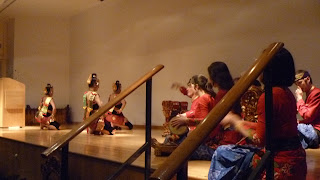Yesterday (13 October) was the second edition of Indonesia Kontemporer, a festival of contemporary Indonesian arts and culture held again at SOAS. At the first edition a year ago, I was an active participant, performing A Dalang in Search of Wayang. This time round I was a spectator, albeit an interested one. There was a fuller programme than last year, and it seems more people in attendance too, and I managed to attend a fair sampling of the events, though I didn't get to see any of the films on offer (curated by SOAS lecturer Ben Murtagh).
I started out by dropping by a small display of UK-based Indonesian artists, mostly students or ex-students. A number of the artists referenced Indonesian traditional arts in various ways. One of them, Arati Sirman, who studied fine art at Central Saints Martins and art business at Sotheby's, showed a series of works based in part on the illustrations of Hardjowirogo's famous wayang dictionary, Sejarah Wayang Purwa. (See above.)
I attended an artist talk by an English community artist named Helen Marshall about an upcoming Arts Council funded project called Tobong, conducted in collaboration with a Javanese photographer named Risang Yuwono who she met while travelling in Sulawesi. Marshall, who described herself in the talk as a contemporary artist who works in socially engaging modes, went off on motor bike with Yuwono and spent a day visiting an itinerant kethoprak troupe performing on the outskirts of Yogyakarta. This offered a glimpse of their off-stage life, living in the Tobong that is both stage and temporary home. She has research and development money from the Arts Council England to return to Indonesia and stage with Yuwono a series of kethoprak-related events in Yogyakarta in November and December of this year. Among these is to produce 'tableau vivant' -- posing the actors in the same figurations as photographs of them.
Marshall doesn't speak Indonesian or Javanese (a video she showed to us had one of the kethoprak actors say on camera that she should be told to learn Indonesian) and has some rather romantic ideas about the life of these artists and the theatre they perform. And she unfortunately talks about this as a 'collaboration' with the kethoprak performers while saying at the same time that she could never explain her intentions to them. But at least the actors will be paid - she has budgeted in 'modelling fees' for their work. And she also hopes to bring Yuwono to the UK - which would be a good opportunity for him, I suppose.
I next went to a performance of a PPI student group playing songs from around Indonesia. The lead female vocalist was fairly talented, but the accompanying musicians were a mixed lot as one might imagine. The group showed slides taken off the web while they played. A strange moment for me was seeing one of my own performances (the York wayang I did last April) during a slide show of images from the cultural attache's website.
While I was at the talk and concert, my daughter Hannah attended an Indonesian language workshop and I stopped by a couple of times to see how she was doing. A group of adults sat around a circle and were asked various questions by a young man from Jember about their experiences of going to Indonesia and the differences between life in Indonesia and the UK. He encouraged the workshop participants to go to the Indonesian language classes run on Saturday afternoons in the embassy - and there is free Indonesia food too, he said.
I rounded out the day with two Balinese shows on the stage of the Brunei Lecture Theatre. Segara Madu, a gender wayang group run by SOAS lecturer Nick Gray, performed a number of pieces out of the wayang repertoire and a new composition in Balinese style. I was pretty amazed by the huge number of people in attendance.
This was followed by the festival's highlight, a concert of the London-based Balinese gamelan group Lilia Cita and their sister group, the Balinese dance troupe Lila Bhawa, directed by Made Pujawati. Among the items on offer were Jocasta, a new dance drama based on the Oedipus story (pictured above). The audience, very full, applauded all the pieces enthusiastically.
Throughout the festival I was playing around with my new toys - an iPad provided by my department and my new smart phone - and uploading images to Facebook while the event was going on. I tried as well to upload a video of Jocasta, but the file was too large and only just this morning was able to get it into Dropbox. I did think it was rather cool though that I was able to be (in a sense) a live reporter on the spot, putting my status as 'At Indonesia Kontemporer 2012' and posting images and getting responses (including two 'likes' from family members of one of the artists) as I was watching performances. So while much of the cultural materials at the festival felt familiar, this mediation offered a new experience for me.
Sunday, October 14, 2012
Indonesia Kontemporer 2012
Labels:
art,
Bali,
festival,
Gamelan,
gender wayang,
Indonesia,
kethoprak,
Lila Bhawa,
Lila Cita,
London,
PPI,
Segara Madu,
SOAS
Subscribe to:
Post Comments (Atom)





No comments:
Post a Comment